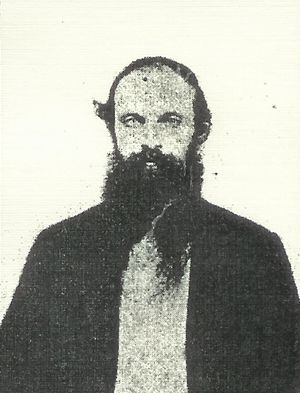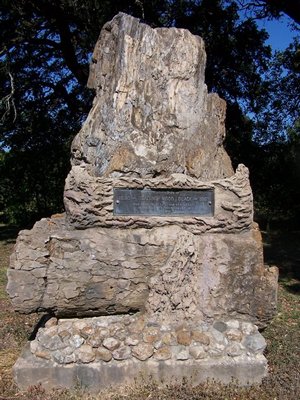|
|
The
northern end of South Texas
is still considered by many as a remote, desolate area that could
only be home to rattlesnakes, horned toads, scorpions and occasionally
an outlaw. It is, on the other hand, a beautiful country abound with
clear rivers, solitude and an abundance of game and I am here to tell
there was a time when it was all of this and much more.
In the mid 1800’s the conflicts with the Indians slowed the settling
of this area. The forts that were built along the road from San
Antonio to El
Paso did slow these conflicts and opened up the way for small
settlements along the road. Fort Inge was founded on March 13, 1849
by the banks of the Leona River. It was the security for the settlement
of what would later become the town of Uvalde,
Texas.
Reading
Black was born September 23, 1830 in New Jersey the ninth child of
a Quaker family. The family was very wealthy and to leave them was
hard but the twenty one year old Reading was smitten by the tales
of Texas. Reading’s father was not happy
with his son’s decision to follow these stories. In 1852, Reading
and his friend Nathan L. Stratton packed their “duds” and headed to
the frontiers of Texas. |
 |
Reading
Black
Photo courtesy Linda Kirkpatrick |
At
about this same time in Canada, George Washington (Tom) Wall and his
family were beginning to get the itch to come to Texas.
In 1856 Tom with his family and the Duncan Wall family set out for
new beginnings. Somewhere along the way they teamed up with the family
of John Leakey, the founder of the town of Leakey,
Texas.
With the desire to make their funds stretch as far as possible Black
purchased a league and a labor near the head of the Leona River, the
future site of the city of Uvalde,
Texas. He established a store, built a home, and laid out the
future town. He became a prominent member of the community both financially
and politically. His political beliefs caused him to have exile in
Mexico until
the end of the Civil War. He established himself in Mexico and returned
to Uvalde
in 1866.
The Wall’s and Leakey’s settled in and around the Uvalde
area in the Sabinal Canyon. In 1855 John Leakey was involved in an
argument over an irrigation ditch that ultimately ended in the death
of a man. Leakey was tried and acquitted. But things heated up for
him and he decided to leave the Patterson Settlement, but before the
family could get packed and outta there, John was involved in his
famous battle with the Indians which only made him want to leave the
area that much faster.
Recovered from his wounds he during the Indian skirmish, along with
his friends, Tip Stanford, Duncan Wall and Tom Wall, moved to the
Frio Canyon and established a shingle making and freight business.
In 1864, Tom Wall’s wife, Kessiah passed away and was laid to rest
on their place north of Leakey.
At this time Tom was in the trade operation between Texas
and Mexico so
he farmed his children out to neighbors in order to continue his business.
In 1867, he married Amelda McKinney, the sister-in-law of one Reading
Black of Uvalde,
Texas. This would be the beginning of what would later become
a tragic event for the now connected families. The distance between
Uvalde
and Leakey
is about forty miles.
Texas was slow to mend the division caused
by the war and Reading’s political opinions and his representations
made him as easy target and may have played a part in his demise or
maybe not. However it may be, Reading and the new family member, Tom
Wall became partners in livestock and Tom loaned Reading money to
open a store. Reading would run the store and tend the stock while
Tom ran the trade routes. Monies were co-mingled and the partnership
was stretched.
One family member on the Wall side tells that Tom, in 1867, returned
from one of his trips to find that the partnership stock had been
sold and the money put into the store. Tom tried to collect the loan
or the money from the livestock sale but in the end he and Reading
quarreled and Tom walked out stating that he would be back the next
day to kill Reading or to collect the money. This was in the day when
a man’s word was true.
Several of Reading’s friends offered to bail him out but Reading seemed
unconcerned probably thinking that the family ties and a good sleep
would cure Tom’s rage, a bad decision on his part because the next
morning, bright and early Tom rode into Uvalde
on his gray horse.
Reading was spending a usual morning in the store visiting with customers
when Wall walked up to him demanding the one hundred dollars. When
Reading refused and made a move for a gun Tom Wall shot him dead on
the spot. Tom was out the door in an instant, heading old gray south
for Mexico.
He remained in Mexico,
part of the time confined to a jail but bought his freedom in 1868.
|
 |
 |
One of Reading
Black's stone, and plaque
Photo courtesy Linda Kirkpatrick, October 2007 |
It is said that
many motives may have led to the killing other than the money issue,
one being that Wall may have just been a spark that was fanned by
political issues that used him as their pawn. Since there was never
a trail no one knows for sure. But it is believed that “while Wall’s
action is indefensible, the greater guilt lies elsewhere.” The Express
News, July 8, 1867.
Wall did make his way back to Texas as
a fugitive. His family hid him in a cave south of Leakey
for safe keeping. It was there that they carried food, supplies and
news of the outside. After about a year of cave confinement his family,
in the dark of night, escorted him to the Oklahoma border, his final
destination - Canada. He was never heard from again.
Just one tragic tale of two early South
Texas settlers. |
View of Reading
Black's stone in Uvalde Cemetery
Photo courtesy Linda Kirkpatrick, October 2007 |
|
|